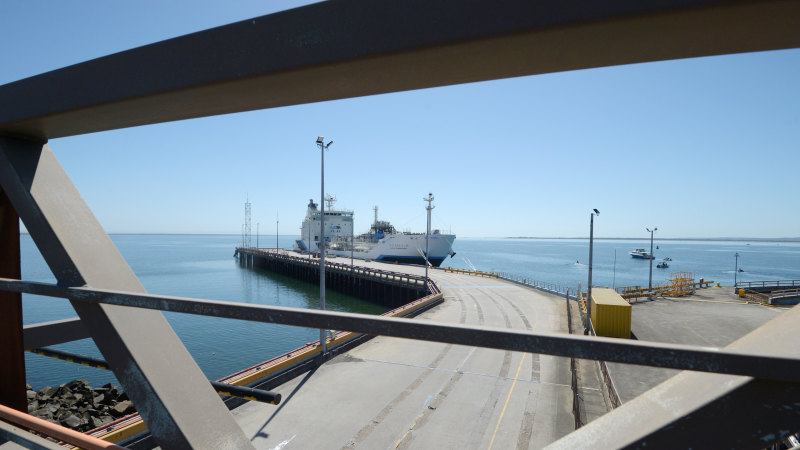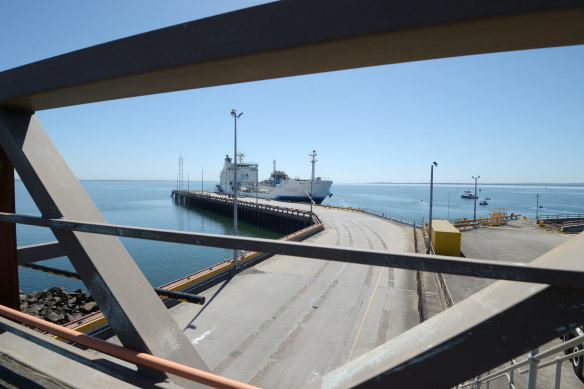Save articles for later
Add articles to your saved list and come back to them any time.
More than $2 billion has been committed to grow the nation’s emerging hydrogen industry as part of $4 billion in renewable energy spending, with subsidies to combat growing international competition for the green fuel’s market share in Asia.
Federal Treasury expects the $2 billion Hydrogen Headstart program to be implemented as a credit per kilogram on the price of production, as well as supporting development of shared industrial infrastructure in the most prospective locations, such as Wollongong, Gladstone or Whyalla.
A liquid hydrogen carrier moored at the Port of Hastings in Victoria.Credit: Bloomberg
The fund is a direct response to the United States, which last year signalled hundreds of billions of forecast spending under a $US3 a kilogram tax rebate for hydrogen production under President Joe Biden’s Inflation Reduction Act. That is expected to make the US the world’s lowest cost producer of green hydrogen.
The budget papers said government funding was needed to compete with the US and other jurisdictions that offered generous support to green industries, such as Canada and the European Union.
“Seizing these kinds of industrial and economic opportunities will be the biggest driver and determinant of our future prosperity,” Treasurer Jim Chalmers said, adding that the government was investing to realise Australia’s “future as a renewable energy superpower”.
Hydrogen is a fuel that burns cleanly and only emits water. It offers a greener option for some major global industries that have the fewest options to decarbonise their production, such as aviation, shipping and freight.
The budget contained little detail of how the hydrogen funding would be spent, but Climate Change and Energy Department officials said the scheme would focus on green hydrogen and be finalised in coming months after industry consultation. The budget papers commit only $156 million in spending over the forward estimates, with the rest of the $2 billion being held in contingency reserves.
Green hydrogen is produced with renewable energy and has no emissions, while blue hydrogen is produced with energy from fossil fuels, requiring the use of carbon capture and storage to eliminate emissions.
Climate Change and Energy Minister Chris Bowen said last month: “there’s an urgent need to speed up priority pilot projects and hydrogen hubs to compete internationally”.
A Deloitte Economics report in February said Australia was at a “hydrogen tipping point” due to the US subsidy scheme, warning that a failure to respond would cause Australia to export 65 per cent less a year than it would without Biden’s massive support package.
Deloitte said the “goldilocks zone” for subsidies would be $2 a kilogram, about half the value of the US scheme, due to Australia’s competitive advantages of access to vast wind and solar power resources and proximity to major growth markets in big energy importing nations such as Singapore, Japan and Korea.
Industry has backed-in this scheme, and in March Fortescue Metals Group executive chairman Andrew Forrest – Australia’s leading hydrogen proponent – said Australia would ignore international competition “at our peril”, warning that he would have to prioritise his US projects due to the generous subsidies on offer.
Government is betting on hydrogen as a key industry to drive industrial growth under its legally binding climate goal to decarbonise the economy by 2050.
Bowen has said the industry could generate $50 billion in GDP by 2050 and create 16,000 jobs.
In addition to the hydrogen program, the government has committed $1.3 billion to its household energy upgrades fund, which subsidises interest rates on private loans for households switching to greener appliances and improving their home’s energy efficiency.
Last week, Bowen announced a National Net Zero Authority, backed with $400 million in funds, to guide the economic transition, particularly for communities and workers in fossil fuel producing regions.
Cut through the noise of federal politics with news, views and expert analysis from Jacqueline Maley. Subscribers can sign up to our weekly Inside Politics newsletter here.
Most Viewed in Politics
From our partners
Source: Read Full Article

